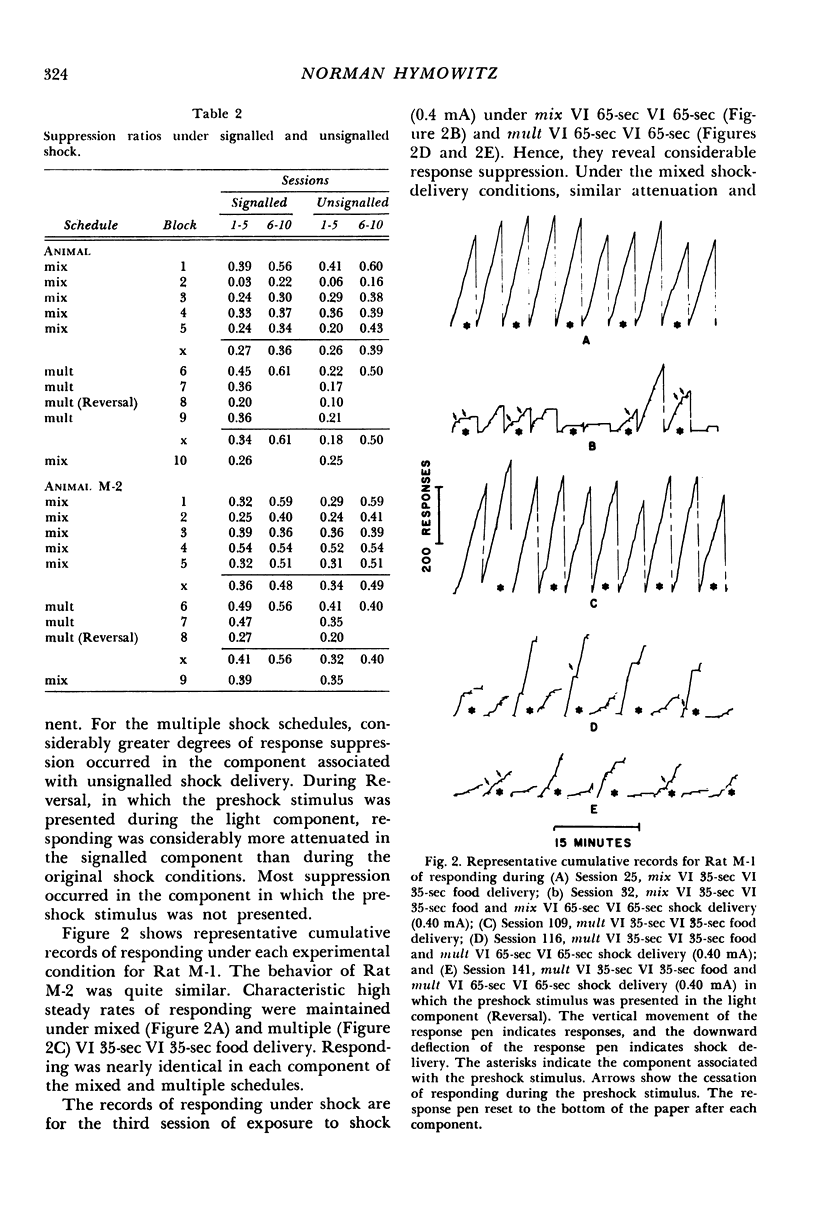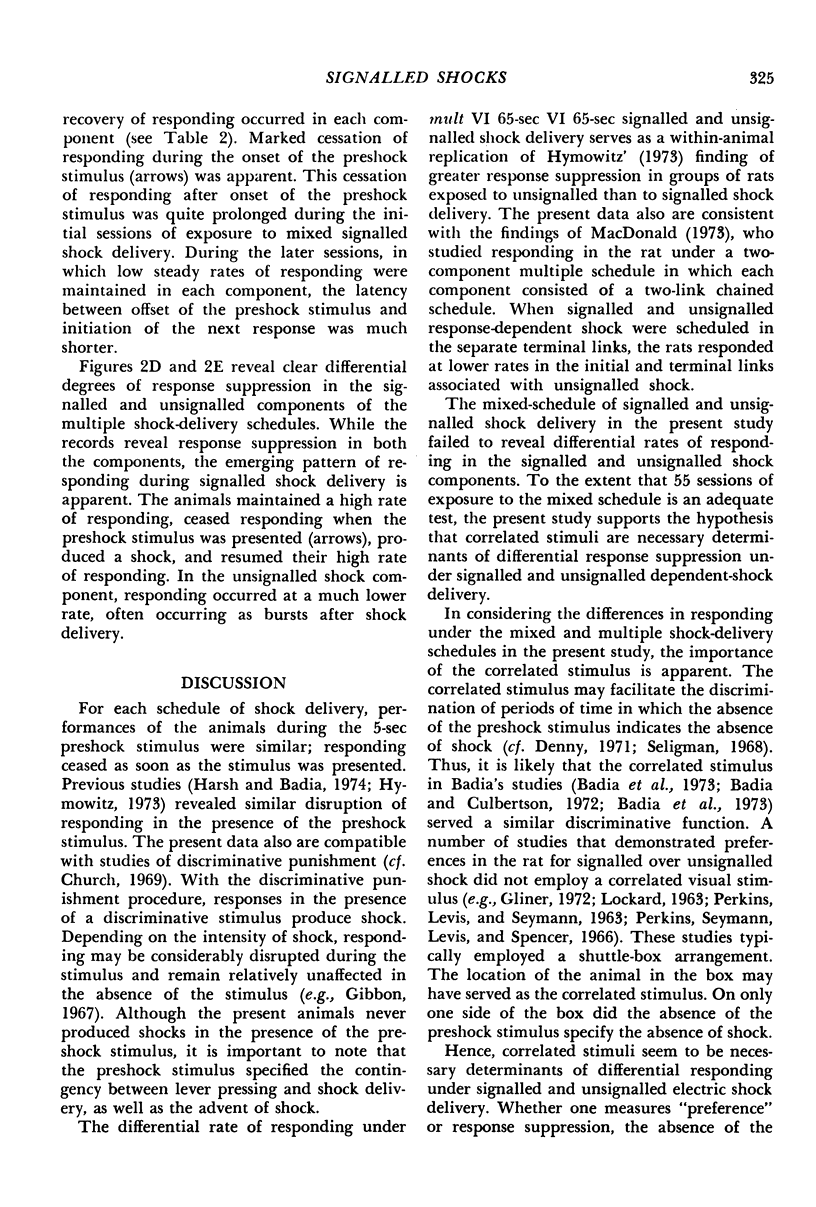Abstract
Responding in two rats was maintained under mixed and multiple variable-interval 35-sec variable-interval 35-sec food delivery schedules. Similar rates and patterns of responding occurred in each component of the two schedules. Mixed and multiple variable-interval 65-sec variable-interval 65-sec schedules of response-dependent shock delivery were super-imposed on the mixed and multiple baseline food schedules, respectively. In one component, a 5-sec stimulus was presented on the average of once every 65 sec. Offset of the stimulus arranged that the next response would produce shock. In the other component, no stimulus was presented during the 5-sec period. The mixed schedule of signalled and unsignalled dependent shock delivery yielded similar degrees of response suppression in each component, but the multiple schedule of shock delivery revealed differential degrees of response suppression. Considerably more suppression occurred in the component not associated with the preshock stimulus, thus implicating the discriminative functions of the correlated stimulus.
Keywords: electric shock, punishment, multiple schedule, mixed schedule, rats
Full text
PDF





Selected References
These references are in PubMed. This may not be the complete list of references from this article.
- Badia P., Coker C., Harsh J. Choice of higher density signalled shock over lower density unsignalled shock. J Exp Anal Behav. 1973 Jul;20(1):47–55. doi: 10.1901/jeab.1973.20-47. [DOI] [PMC free article] [PubMed] [Google Scholar]
- Badia P., Culbertson S., Harsh J. Choice of longer or stronger signalled shock over shorter or weaker unsignalled shock. J Exp Anal Behav. 1973 Jan;19(1):25–32. doi: 10.1901/jeab.1973.19-25. [DOI] [PMC free article] [PubMed] [Google Scholar]
- Badia P., Culbertson S. The relative aversiveness of signalled vs unsignalled escapable and inescapable shock. J Exp Anal Behav. 1972 May;17(3):463–471. doi: 10.1901/jeab.1972.17-463. [DOI] [PMC free article] [PubMed] [Google Scholar]
- Gibbon J. Discriminated punishment: avoidable and unavoidable shock. J Exp Anal Behav. 1967 Sep;10(5):451–460. doi: 10.1901/jeab.1967.10-451. [DOI] [PMC free article] [PubMed] [Google Scholar]
- Gliner J. A. Predictable vs. unpredictable shock: preference behavior and stomach ulceration. Physiol Behav. 1972 Nov-Dec;9(5):693–698. doi: 10.1016/0031-9384(72)90036-4. [DOI] [PubMed] [Google Scholar]
- Hymowitz N. Comparisons between variable-interval and fixed-interval schedules of electric shock delivery. J Exp Anal Behav. 1973 Jan;19(1):101–111. doi: 10.1901/jeab.1973.19-101. [DOI] [PMC free article] [PubMed] [Google Scholar]
- LOCKARD J. S. Choice of a warning signal or no warning signal in an unavoidable shock situation. J Comp Physiol Psychol. 1963 Jun;56:526–530. doi: 10.1037/h0041552. [DOI] [PubMed] [Google Scholar]
- Macdonald L. The relative aversiveness of signalled versus unsignalled shock-punishment. J Exp Anal Behav. 1973 Jul;20(1):37–46. doi: 10.1901/jeab.1973.20-37. [DOI] [PMC free article] [PubMed] [Google Scholar]
- Perkins C. C., Jr, Seymann R. G., Levis D. J., Spencer R., Jr Factors affecting preference for signal-shock over shock-signal. J Exp Psychol. 1966 Aug;72(2):190–196. doi: 10.1037/h0023491. [DOI] [PubMed] [Google Scholar]
- Seligman M. E. Chronic fear produced by unpredictable electric shock. J Comp Physiol Psychol. 1968 Oct;66(2):402–411. doi: 10.1037/h0026355. [DOI] [PubMed] [Google Scholar]


